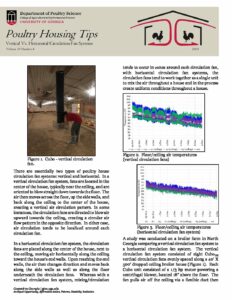There are essentially two types of poultry house circulation fan systems: vertical and horizontal. In a vertical circulation fan system, fans are located in the center of the house, typically near the ceiling, and are oriented to blow straight down towards the floor. The air then moves across the floor, up the side walls, and back along the ceiling to the center of the house, creating a vertical air circulation pattern. In some instances, the circulation fans are directed to blow air upward towa...rds the ceiling, creating a circular air flow pattern in the opposite direction. In either case, air circulation tends to be localized around each circulation fan.
In a horizontal circulation fan system, the circulation fans are placed along the center of the house, next to the ceiling, moving air horizontally along the ceiling toward the house’s end walls. Upon reaching the end walls, the air then changes direction and moves back along the side walls as well as along the floor underneath the circulation fans. Whereas with a vertical circulation fan system, mixing/circulation tends to occur in zones around each circulation fan, with horizontal circulation fan systems, the circulation fans tend to work together as a single unit to mix the air throughout a house and in the process create uniform conditions throughout a house.
A study was conducted on a broiler farm in North Georgia comparing a vertical circulation fan system to a horizontal circulation fan system. The vertical circulation fan system consisted of eight CuboTM vertical circulation fans evenly spaced along a 40' X 500' dropped ceiling broiler house (Figure 1). Each Cubo unit consisted of a 1/3 hp motor powering a centrifugal blower, located 18" above the floor. The fan pulls air off the ceiling via a flexible duct then blows it out in a 360 degree pattern horizontally across the floor. The horizontal circulation fan system consisted of eight 24", 1/3 hp fans (Multifan 24" - approximately 6,500 cfm @ 0.00") positioned next the ceiling along the centerline of the house, blowing air towards the end walls. The same target temperatures and relative humidity (40 - 60%) were used in both houses.
Though the vertical circulation fan system reduced temperature stratification during brooding to five degrees or less, the horizontal circulation fan system did a better job reducing it to two degrees or lessen (Figures 2 and 3). The biggest differences observed between the two types of circulation fan systems were their abilities to create uniform temperatures throughout the brooding area/house and to generate air movement over the litter, thus promoting litter drying.
With the horizontal circulation fan system, the air within the brooding area/house was mixed from end to end, moving cool air near the brooding curtain/end walls to the center of the house and warmer air near the center of the house to the end walls/brooding curtain. The thorough mixing of the air in the house resulted in consistent house temperatures, which was reflected in more uniform heater runtimes (Figure 4 and 5). Furthermore, a horizontal circulation fan system’s ability to move excessive bird heat from the center of the house towards the end walls, where extra heat is often needed due to tunnel fan and tunnel door leakage, could result in significant fuel savings.
The study also found that a horizontal circulation fan system was able to produce significantly more air movement over the litter throughout a house than the vertical circulation fan system. With the vertical circulation fans, air movement was limited to within 15' to 20' of each fan, while the horizontal circulation fans worked together as a system, creating air speeds of between 100 - 150 ft/min over most of the house’s floor area, which in turn resulted in overall drier litter and improved paw health. Though there was more air movement, no adverse chick reactions were observed.
The study illustrated that there is much more to be gained from a circulation fan system than simply moving hot air off the ceiling. A proper circulation fan system can not only break up temperature stratification, but also promote more uniform house conditions, drier litter, and improved foot pad health as well (Figures 6 and 7).
Details
| Year | Volume | Number | Categories |
|---|---|---|---|
| 2023 | 35 | 4 |

